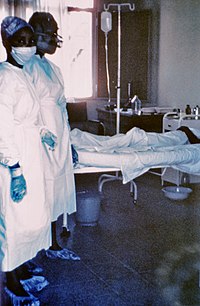
Photo from wikipedia
Background In addition to their direct pathogenic effects, arthropod-borne (arboviruses) have been hypothesized to indirectly contribute to hospitalizations and death through decompensation of pre-existing comorbidities. Using nationwide data routinely collected… Click to show full abstract
Background In addition to their direct pathogenic effects, arthropod-borne (arboviruses) have been hypothesized to indirectly contribute to hospitalizations and death through decompensation of pre-existing comorbidities. Using nationwide data routinely collected from 1 January 2014 to 31 December 2019 in Brazil, we investigated whether local increases in arbovirus notifications were associated with excess hospitalization. Methods We estimated the relative risks for the association between municipality- and state-level increases in arboviral case notifications and age-standardized hospitalization rates (i.e., classified as direct or indirect based on ICD-10 codes) using Bayesian multilevel models with random effects accounting for temporal and geographic correlations. For municipality-level analyses, we excluded municipalities with <200 notifications of a given arbovirus and further adjusted the models for the local Gini Index, Human Development Index, and Family Healthcare Strategy (Estratégia de Saúde da Família) coverage. Models for dengue, Zika, and chikungunya were performed separately. Results From 2014 to 2019, Brazil registered 7,566,330 confirmed dengue cases, 159,029 confirmed ZIKV cases, and 433,887 confirmed CHIKV cases. Dengue notifications have an endemic and seasonal pattern, with cases present in 5334 of the 5570 (95.8%) Brazilian municipalities and most (69.5%) registered between February and May. Chikungunya notifications followed a similar seasonal pattern to DENV but with a smaller incidence and were restricted to 4390 (78.8%) municipalities. ZIKV was only notified in 2581 (46.3%) municipalities. Increases in dengue and chikungunya notifications were associated with small increases in age-standardized arbovirus-related hospitalizations, but no consistent association was found with all-cause or other specific indirect causes of hospitalization. Zika was associated to increases in hospitalizations by neurological diseases. Conclusions Although we found no clear association between increased incidence of the three arboviruses and excess risks of all-cause or indirect hospitalizations at the municipality- and state-levels, follow-up investigations at the individual-level are warranted to define any potential role of acute arbovirus infection in exacerbating risks of hospitalization from underlying conditions.
Journal Title: PLoS Neglected Tropical Diseases
Year Published: 2022
Link to full text (if available)
Share on Social Media: Sign Up to like & get
recommendations!